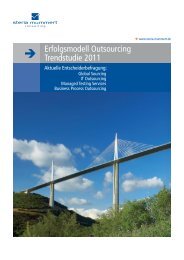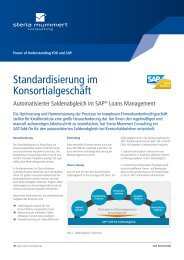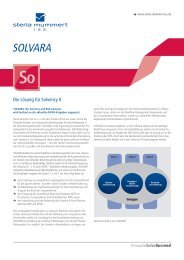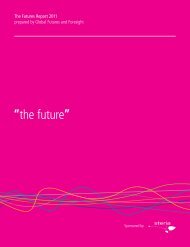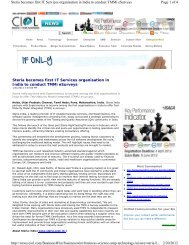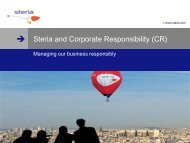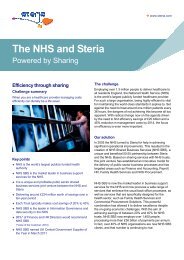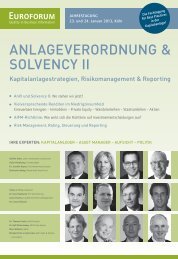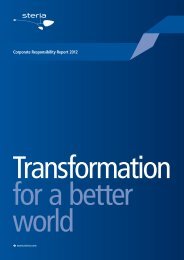The Future Report Dr Jörg Raaymann - Steria
The Future Report Dr Jörg Raaymann - Steria
The Future Report Dr Jörg Raaymann - Steria
Create successful ePaper yourself
Turn your PDF publications into a flip-book with our unique Google optimized e-Paper software.
<strong>The</strong> <strong>Future</strong> <strong>Report</strong><br />
Leadership Perspectives<br />
<strong>Dr</strong> Jörg <strong>Raaymann</strong><br />
CIO of Landesbank Hessen-Thüringen Girozentrale<br />
With 5,900 employees and a balance sheet total of<br />
€166.5 billion (30.06.2012), the Helaba Group is one<br />
of Germany’s leading ‘Landesbanken’ or regional state<br />
banks. It operates two central offices in Frankfurt am<br />
Main and Erfurt, as well as branches, holdings and a<br />
presence in many of the world’s major financial centres.<br />
Chief Information Officer, <strong>Dr</strong> Jörg <strong>Raaymann</strong>, outlines how<br />
key trends highlighted in the <strong>Future</strong> <strong>Report</strong> will impact<br />
on two important areas of focus for the Helaba Group:<br />
“Technology is of great interest to us as an integrated universal bank<br />
with a strong regional focus. One internal challenge we currently face is<br />
the reorganisation of our staff. Our main headquarters are in Frankfurt<br />
and Erfurt, with two national locations in Kassel and in Düsseldorf.<br />
Our presence in Düsseldorf is a result of our recent takeover of part of<br />
the Westdeutsche Landesbank. We also have an international presence<br />
in London, New York, Dublin, Madrid, Paris, Shanghai and Moscow.<br />
Our IT staff are placed in Offenbach near Frankfurt, Düsseldorf, Kassel,<br />
London, Dublin and New York. As far as our work processes and<br />
workplace design are concerned, technological developments make<br />
a huge difference to us at a time like this.<br />
<strong>The</strong> second area of significance for me is how trends like demographic<br />
change will impact our employees. Ageing populations, and<br />
other changes to society, will affect what our employees<br />
demand of us. Consequently, we will also have to invest<br />
in the education and development of young<br />
employees as well as the development<br />
of our mature staff to maintain our<br />
capability to meet the needs of<br />
our business departments.”
Technology/Outsourcing<br />
Working in the cloud for a grounded future<br />
“Together with our data-centre provider, we have tried out and<br />
implemented various cloud-based approaches. For example, our<br />
entire SAP architecture is virtualised in a private cloud. This trend<br />
towards virtualisation will continue. We are giving more and more<br />
space to virtualisation technology within our IT infrastructure<br />
and aim to extensively move away from physical servers. In terms<br />
of applications, I can see us increasing our use of ASP models<br />
and we’ll find providers to operate and develop these for us. As<br />
far as commodity applications go, the market is already there<br />
and I predict that business applications will go this way too.<br />
Our aim is to ensure that our IT applications can be quickly<br />
adapted in line with changes in our marketplace – and that we<br />
retain an attractive relationship between cost and benefit.”<br />
Business Models<br />
Collaborative tools for effective teamwork<br />
“<strong>The</strong> use of collaborative networking tools is an important theme for<br />
us. This provides immense opportunities for efficient and meaningful<br />
collaboration between our decentralised staff teams. At the moment,<br />
we are conducting a study on the use of Sharepoint. We are also<br />
examining the use of unified communications and videoconferencing<br />
from the workplace. <strong>The</strong>se systems will continue to change the<br />
working life of every one of us.<br />
Of course, you have to ask the question, “Does this just look good or<br />
is it actually benefitting the bank?” My response is that collaborative<br />
networking and unified communication will certainly be playing<br />
a major role in the modernisation of our ICT infrastructure.”<br />
Population<br />
Staying ahead of the demographic curve<br />
“At Helaba, the widest part of our demographic pyramid in terms of<br />
IT use is made up of middle-aged staff – the average age in our IT<br />
division being around 44. It is our aim to train young people in our<br />
organisation to achieve a balance between these and our mature<br />
staff. So, we’ve established a scheme for young professionals and<br />
those who show the necessary potential are assisted and educated.<br />
Three years ago, we also introduced skill management in this area<br />
and maintain a catalogue of 40 different roles and 250 types of<br />
skills. Roles are distinguished as primary or secondary, with skills<br />
being defined as ‘those who know it’, ‘those who can do it’ and<br />
‘those who are experts in it’. Each person assesses his or her own<br />
abilities and the outcome is then discussed in their appraisal.<br />
I believe we are sitting on a veritable gold mine with this strategy!<br />
<strong>The</strong> qualification requirements that can be derived from this will<br />
allow us to attune skillsets to our exact requirements. We have a<br />
catalogue of training modules which are designed to meet future<br />
needs. From this, our staff can select which training activities<br />
they get involved in, depending on their requirements and the<br />
profile of their jobs. This will help our older employees to keep<br />
their knowledge up to date and remain employable. At the same<br />
time we will develop the expertise we need for the future.”



